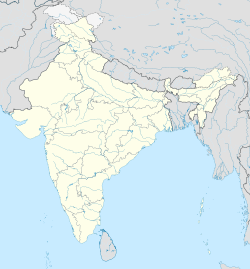Khurja
| Khurja | ||
|---|---|---|
| Staat: | ||
| Bundesstaat: | Uttar Pradesh | |
| Distrikt: | Bulandshahr | |
| Subdistrikt: | Khurja | |
| Lage: | 28° 15′ N, 77° 51′ O | |
| Höhe: | 204 m | |
| Einwohner: | 111.062 (2011)[1] | |
| Website: | www.khurja.co.in | |
Khurja ist eine Stadt im nordindischen Bundesstaat Uttar Pradesh.
Lage und Verkehrsanbindung
Khurja liegt in der nordindischen Ebene 75 km südöstlich von Neu-Delhi. Die Stadt befindet sich im Distrikt Bulandshahr.
Die nationale Fernstraße NH 91 verbindet die Stadt mit der 17 km nördlich gelegenen Distrikthauptstadt Bulandshahr und mit dem 45 km südsüdöstlich gelegenen Aligarh.
Khurja besitzt als Stadt den Status eines Nagar Palika Parishad. Sie ist in 25 Wards gegliedert. Beim Zensus 2011 hatte Khurja 111.062 Einwohner.
Keramik aus Khurja

Khurjia ist in ganz Indien und darüber hinaus bekannt für seine keramischen Erzeugnisse. Die Tradition der Keramikherstellung ist schon einige Jahrhunderte alt und geht der Überlieferung nach auf den zentralasiatischen Eroberer Timur zurück, der im 15. Jahrhundert mit seinem Heer auch einige Töpfer aus Ägypten und Syrien in die Gegend brachte. Im Jahr 2015 waren etwa 5000 Handwerker und Künstler, sowie zahlreiche ungelernte Arbeiter in ungefähr 500 Keramikwerkstätten in Khurja tätig. Am 1. Juni 2025 erhielt die Keramik aus Khurja das Geographical Indication (GI)-Siegel durch das indische Handels- und Industrieministerium, vergleichbar der geschützten Ursprungsbezeichnung in der Europäischen Union.[2][3]
Weblinks
Einzelnachweise
- ↑ www.census2011.co.in
- ↑ Shailvee Sharda: GI certificate to preserve uniqueness of Khurja pottery. In: The Times of India. 1. Juni 2015, abgerufen am 2. Januar 2022 (englisch).
- ↑ STATE WISE REGISTRATION DETAILS OF G.I APPLICATIONS. Office of the Controller General of Patents, Designs & Trade Marks, Department for Promotion of Industry and Internal Trade, Ministry of Commerce & Industry, Government of India, abgerufen am 2. Januar 2022 (englisch).
Auf dieser Seite verwendete Medien
Autor/Urheber: AshwiniKalantri, Lizenz: CC BY-SA 3.0
Location map of India. Equirectangular projection. Strechted by 106.0%. Geographic limits of the map: * N: 37.5° N * S: 5.0° N * W: 67.0° E * E: 99.0° E Made with Natural Earth. Free vector and raster map data @ naturalearthdata.com.
Autor/Urheber: Sankoswal, Lizenz: CC BY-SA 4.0
Khurja Pottery is traditional ceramic pottery art with relief work using earth colours like orange, brown and terracotta worked on to a white background, giving them a rich artistic appearance. The highly creative and artistic products include decorative items tableware, utensils, and the like, rich in both composition and quality.
Khurja city is now famous for its Khurja Pottery and ceramics. Khurja supplies a large portion of the ceramics used in the country, hence it is sometimes called The Ceramics City.
The history of Khurja Pottery goes back to around 14th century, when some retreating (wounded) soldiers from Timur's army decided to stay back. Most of these soldiers were potters and they brought their art of pottery with them. Starting with red clay pottery they moved on to blue glaze and on red clay articles with engobe of white clay, painting floral designs with cupric oxide and applying a soft glaze containing glass and borax etc.
During World War II, ban was imposed on various metals for making household utensils and import of ceramic goods was drastically curtailed. To meet the demand of ceramic wares mainly for war hospitals, the Government of Uttar Pradesh established a ceramic unit. After the war, the factory was closed down in 1946 due to lack of demand of its products. The factory was equipped with three small kilns, two chimneys and three ball mills. The Government of Uttar Pradesh made a thoughtful consideration for the utilization of the available machinery, other capital items and instead of closing it down, converted into a Pottery Development Centre. It was the first pottery related to common facilities Center in the country where entrepreneurs were provided the facilities for firing their green wares in the Government kilns.


